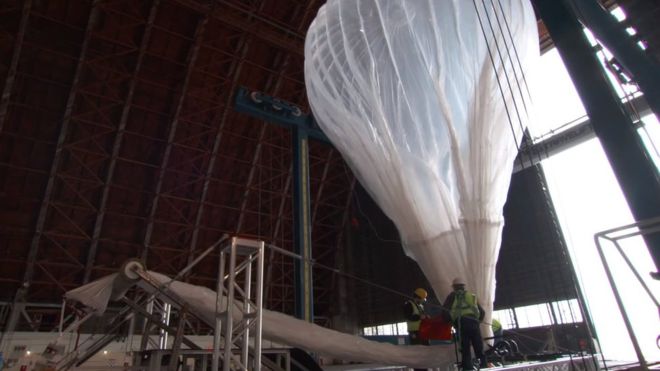
Wellington, New Zealand (BBN)-Google believes it is on course to have enough internet-beaming balloons in the stratosphere to form a ring over part of the world next year.
It told the BBC the move would let it trial a continuous data service to people living below the balloons' path.
The declaration coincides with the announcement that three of Indonesia's mobile networks intend to start testing Project Loon's transmissions next year, reports BBC.
One expert said the plan had benefits over other solutions.
Sri Lanka previously signed a separate agreement signalling its wish to be another participant in the giant helium balloon-based scheme.
4G-LIKE SPEEDS
Google first revealed its superpressure balloon plan in June 2013, when about 30 of the inflatable plastic "envelopes" were launched from New Zealand.
The original set-up provided 3G-like data speeds, but the kit can now supply connected devices with about 10 megabits a second to connected devices via antennae on the ground. For comparison's sake, the average 4G connection in the UK is 15Mbit/sec.
There have also been other advances.
"In the early days, the balloons would last five or seven or 10 days. Now we have had balloons that have lasted as long as 187 days," Mike Cassidy, vice-president of Project Loon, told the BBC.
"We've also improved the launch process.
"It used to take 14 people an hour or two to launch a balloon, now with an automated crane we can launch a balloon every 15 minutes with two or three people."
If all goes according to plan, he added, the experiment should achieve one of its goals in 2016.
"[We need] about 300 balloons or so to make a continuous string around the world," he explained.
"As one moves along with the wind out of range, another one comes to take its place.
"We hope next year to build our first continuous ring around the world, and to have some sort of continuous coverage for certain regions.
"And if all goes well after, then after that we will start rolling out our first beta commercial customers."
Because each balloon only provides connectivity to a ground area 40km (24.9 miles) in diameter below it, the initial ring will be limited to a relatively small part of the planet as it circles a section of the Southern Hemisphere.
WHAT ARE SUPERPRESSURE BALLOONS?
Superpressure balloons are made out of tightly sealed plastic capable of containing highly pressurised lighter-than-air gases.
The aim is to keep the volume of the balloon relatively stable, even if there are changes in temperature.
This allows them to stay aloft longer and be better at maintaining a specific altitude than balloons which stretch and contract.
In particular, it avoids the problem of balloons descending at night when their gases cool.
The concept was first developed for the US Air Force in the 1950s using a stretched polyester film called Mylar.
The effort resulted in the Ghost (global horizontal sounding technique) programme which launched superpressure balloons from Christchurch, New Zealand, to gather wind and temperature data over remote regions of the planet.
Over the following decade, 88 balloons were launched, the longest staying aloft for 744 days.
More recently, Nasa has experimented with the technology and suggested superpressure balloons could one day be deployed into Mars's atmosphere.
Google suggests that Project Loon would be a cheaper solution than installing fibre optic cables or building mobile phone masts across all of Indonesia's islands, which contain jungles and mountains.
It says the scheme would help address the fact that more than 100 million people out of the country's 255 million-strong population remain unconnected.
"From Sabang all the way to Merauke, many of these people live in areas without any existing internet infrastructure, so we hope balloon-powered internet could someday help give them access to the information and opportunity of the web," it said in a blog.
The three local networks that are partnering with the scheme are XL Axiata, Indostat and Telkomsel.
"Any country that is struggling to get cabled or land-based wireless infrastructure out to its extreme edges will see satellites or other sky-based internet delivery mechanisms as a viable solution," commented Chris Green, a tech consultant at Davies Murphy Group.
The advantage of a balloon-based system over satellites is that it should ultimately be cheaper to maintain - at least, if all the technological challenges can be overcome.
"What may initially seem like a complex delivery method could end up being a very innovative solution to a very difficult problem to solve at ground level," Green added.
Google is, however, considering other options,
It is also pursuing a separate effort codenamed Titan, which aims to use solar-panelled drones to provide the internet to unconnected parts of the world.
Facebook is also developing a similar drone-based scheme.
BBN/SS/ASI